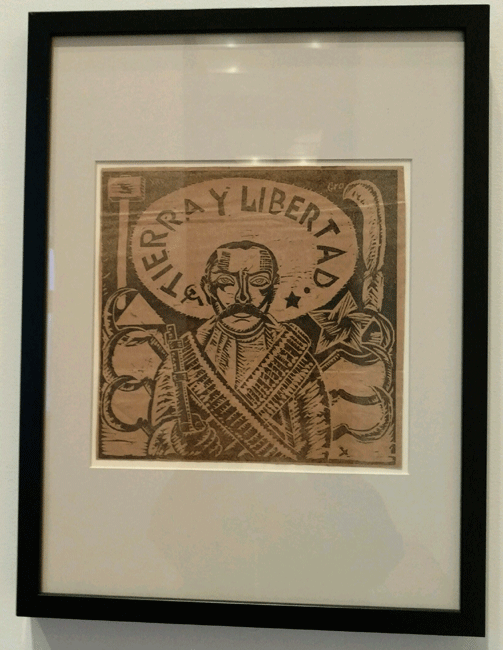Source: WTL photograph© at the Special Exhibition of "Paint the Revolution: Mexican Modernism 1910 - 1950," at the Philadelphia Art Museum, December 13, 2016.
Image:
Framed "Portrait of Emiliano Zapata" by Xavier Guerrero (1896-1974), April, 1924. Woodcut illustration from Revolutionary publication El Machete.
Comments: The battle cry "Tierra y Libertad" is generally associated with Zapata, his movement, and the EZLN, but it is historically inaccurate, for he himself did not use the phrase, although he was fully aware of it. "Tierra y Libertad" is actually a translation from Russian "Zemlya i Volya," which is a revolutionary anarchist black political slogan, which was used in Russia from 1878 through the Russian Revolution. Xavier Guerrero was best known for his work in Mexican Muralism, but he is less known than the most famous muralists because he often worked in collaboration with them, such as, especially, Diego Rivera and Siqueiros, Notably, he worked at the Colegio de San Ildefonso, the Secretaría de Educación Pública, and the Universidad Autónoma de Chapingo. For a time he even lived with Diego Rivera and Frida Kahlo. He had a romantic relationship with Tina Modotti (1896-1942), who introduced him to Stalinist politics, whereafter he was a lifetime communist. Mondotti was an Italian photographer, model, actrice, and member of the Soviet Komintern. Together with Siqueiros, Guerrero founded El Machete, the publication of the Mexican Communist Party, in 1924; hence the woodcut above. He and Siqueiros also founded the Sindicato de Obreros Técnicos, Pintores y Escultores union.
Humanities Question: Comment on the fact that Guerrero has encircled the drawing of Zapata with the communist symbols the hammer and sickle, along with, of course, a machete in the upper right corner.


